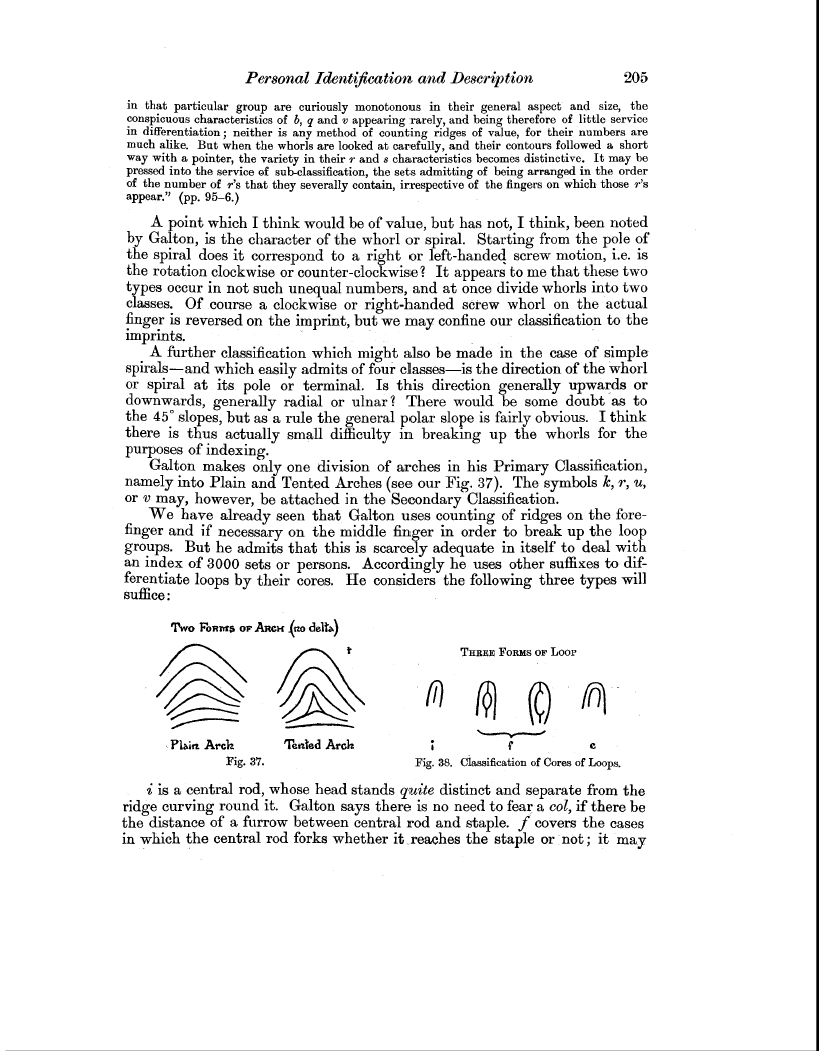| ||||||

OCR Rendition - approximate
Personal Identification and Description 205 in that particular group are curiously monotonous in their general aspect and size, the conspicuous characteristics of b, q and v appearing rarely, and being therefore of little service in differentiation ; neither is any method of counting ridges of value, for their numbers are much alike. But when the whorls are looked at carefully, and their contours followed a short way with a pointer, the variety in their r and s characteristics becomes distinctive. It may be pressed into the service of sub-classification, the sets admitting of being arranged in the order of the number of is that they severally contain, irrespective of the fingers on which those is appear." (pp. 95-6.) A point which I think would be of value, but has not, I think, been noted by Galton, is the character of the whorl or spiral. Starting from the pole of the spiral does it correspond to a right or left-handed screw motion, i.e. is the rotation clockwise or counter-clockwise? It appears to me that these two types occur in not such unequal numbers, and at once divide whorls into two classes. Of course a clockwise or right-handed screw whorl on the actual finger is reversed on the imprint, but we may confine our classification to the imprints. A further classification which might also be made in the case of simple spirals-and which easily admits of four classes-is the direction of the whorl or spiral at its pole or terminal. Is this direction generally upwards or downwards, generally radial or ulnar ? There would be some doubt as to the 45° slopes, but as a rule the general polar slope is fairly obvious. I think there is thus actually small difficulty in breaking up the whorls for the purposes of indexing. Galton makes only one division of arches in his Primary Classification, namely into Plain and Tented Arches (see our Fig. 37). The symbols k, r, u, or v may, however, be attached i n the Secondary Classification. We have already seen that Galton uses counting of ridges on the forefinger and if necessary on the middle finger in order to break up the loop groups. But he admits that this is scarcely adequate in itself to deal with an index of 3000 sets or persons. Accordingly he uses other suffixes to differentiate loops by their cores. He considers the following three types will suffice Two FORMS op ARCH .(no delta) t THREE FORMS OF Loop ni n i is a central rod, whose head stands quite distinct and separate from the ridge curving round it. Galton says there is no need to fear a col, if there be the distance of a furrow between central rod and staple. f covers the cases in which the central rod forks whether it-reaches the staple or not; it may Plain Arch Tented Arch Fig. 37. \~Y~r i f c Fig. 38. Classification of Cores of Loops.
|